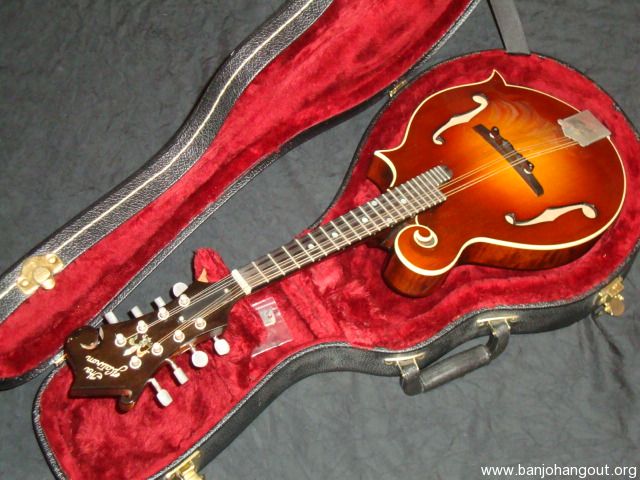

Ren (not Red) was my direct supervisor as head luthier- I started on as head of the finish dept. "If clawhammer were easy to learn, there would be no challenge." Did you fellows work with Red Ferguson or Jim Triggs while they were with Steve Carlson? Thanks to Mike and Stanger for the very interesting Flatiron banjo history! These posts should serve future buyers of Flatirons who need to know what they are looking into. I could have bought one back then, and sure wish I had now. The Big Horn's bound peghead was the only one done this way until the #6 was re-introduced, and was the heads-on equal of the Scruggs Standard. Gibson management decided they were too much competition for both the Gibsons and Epiphones- they were priced right between the 2 lines, but were as good as Gibsons for 2/3 of the Gibsons' prices. The Flats lasted into 1993, but I think production ceased sometime in late 1991. This was the only openback I saw in the 2 years I worked there at that time. This banjo had diamonds in the board, not dots, but was a stock Rose oterhwise except for the pot. Steve had a one-off openback Rose with a 3-ply rim mounted with a Flatiron flathead tone ring that was built as a NAMM showpiece. These banjos were all resonated only- no openbacks. The Rose DeLuxe used this ring, but the construction was Mastertone, so the rim was thicker to allow the use of the Gibson 1-pc. After the buyout, the Whyte Laydie tone ring used on the Rose, and made by Stew-Mac in Bozeman, was replaced by a simple brass tube.

The Montana Rose used rims that Steve bought before the buyout and are thinner. The only difference structurally betwee the Sweetgrass and Bighorn from a Gibson were the tone rings, which were made by the same supplier (Kulesh), but had a slightly different bronze formula. the Gibson parts went to Nashville for final sanding, finish and assembly, and the Flats were completely done in Bozeman. The Flatirons from the Sweetgrass up were made side by side with the Mastertone necks and resonators that were built in-house then. The sale finalized sometime in the first quarter of 1988, and when I went to work there in 89, the factory wasn't fully equipped yet. Mike's date of 1987 was when the banjo production began, and Flatiron had all they could do to just meet demand for their mandolins. Please send your information to the addresses on our contact page.It's highly unlikely that the Montana Rose you found is pre-Gibson. We will, of course, keep your identity anonymous if you prefer.

Send us your pictures, and any other interesting tidbits about your Unicorn.
#THE FLATIRON MANDOLIN F FESTIVAL ARCHIVE#
It is our goal to catalog and archive all information that we can about Unicorn mandolins. To my knowledge there were 149 Unicorns Mandolins built. The wood is different, but the trim on the Unicorn is similar to the Martin trim. A Unicorn-18, or U-18, has the same appointments as a Dreadnought -18, or D-18 Martin, and a U-28 has the same appointments as a D-28. The appointments on the Unicorns were based, roughly speaking, on Martin Guitars.

So, he tried to come up with his version of an A-style mandolin that had the same air displacement as a Loyd Loar. Like many mandolin builders at that time, Rolfe built a few F5 copies, but he didn’t like the fussy detail work of the curls, and thought that they didn’t really add to the sound. He still builds mandolins today, Phoenix Mandolins, but the instrument that I fell in love with was the Unicorn. Rolfe Gerhardt built Unicorn mandolins during the 1970s. Rolfe Gerhardt was one of the first luthiers I was introduced to that put his own brand name on his instruments. During the 70s, Gibson was the only well known name brand, so much so that many builders would build Gibson F5 copies rather than building under their own name. Unicorns are not widely known, and I’ve always felt that they were undervalued. Unicorns have extremely pretty wood, beautiful abalone inlays, are very light weight, have great consistent sound, quality craftsmanship, and full-volume. I fell in love with Unicorn mandolins at a festival in Winfield, Kansas during the 1970s.


 0 kommentar(er)
0 kommentar(er)
